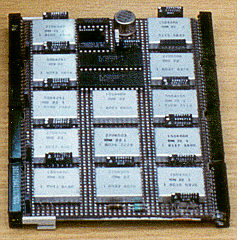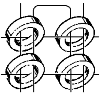IBM 5110

<<< >>> ^^^
| Manufacturer: | International Business Machines (IBM) |
| Type: | 5100 / 5110 |
| Year: | 1976 |
| Technology: | TTL + MOS 64kB RAM(RWS), 284kB ROM(ROS) |
| Price: | 27,000 to 57,000 DEM |
In 1977, the IBM 5100 was the first personal computer at the IfI. However, it was masked as an 'intelligent terminal' at the IfI annual report, because the real computer was called TR440 at the time. The 5100 was IBM's first effort to introduce a personal computer, that means a computer that could be put on the desk. It was introduced in 1975. The special thing is its concept, that everything necessary is integrated in one case. Thus a 5" screen, a QIC tape drive, a keyboard as well as optionally a BASIC- or an APL-interpreter (or both) are united with the central unit to a compact complete system. The main memory ranges from 16 up to 64 kB.
Nevertheless the computer is no lightweight: The description "portable" simply provides an differantiation from the large systems, which were bound to a special location. As accessories there were two serial interfaces, an IEEE-488 interface, a matrix printer with optionally 80 or 120 lines per second and an other external tape drive available. The only manufacturer was IBM, products from other companies for this computer are not known; however, a Braille output line exists that can be connected to the serial interface of this computer.
The computer works internally with full 16 bits, but the ALU is only 8 bits wide. The processor is completely micro-programmed, where the microprogramm is stored in the so-called "Control ROS" (Read Only Storage). In addition to the main memory of up to 64 kB, the computer owns some dozens of kB ROM (resp. ROS), where the monitor program, the interpreters, the tables etc. are stored. Thus the processor can adress more than 64 kB in total for instructions. For non executable ROMs and for the communication with the I/O devices the computer has 16 special device addresses.
The processor has four interrupt levels; level 0 is the normal program execution, the others are for the I/O interrupts. Each level has its own set of 16 registers each 16 bits wide, where register 0 is the program counter. They are mapped at the beginning of the main memory, but are located on the processor card and are correspondingly fast.
By pressing a key on the front panel, the display can be switched, so that instead of the normal output the first 512 bytes of the main memory are shown, that means that also the registers in hex form are visible during execution.
In 1978, IBM introduced the successor, the 5110, this time in two versions: the Model 1 and the Model 2. It became evident that the capacity of a cartridge wasn't very generously dimensioned with its 200 kB. Additionally, the cartridges were not compatible with other computer systems. Thus IBM designed the new series with support to attach 8" floppy disk drives whose recording format was compatible with many IBM systems (and others) of that time, so that exchanging data was made quite simple. The large capacity of up to 1.1 MB, the higher transfer rate and the free positioning of the heads also enabled the possibility to do real data processing and run applications like storage lists, customer management etc. with these computers, wherefore they were used. Accordingly, the Model 2 does not have a tape drive, and the external attachment of a tape drive is not possible. While the 5100 used its own code, IBM changed to the punched card code called EBCDIC on the 5110. This also greatly simplified data exchange.
However the IBM 5100 resp. 5110 were no bestsellers. They were soon replaced by the IBM 5150 - the IBM PC.

CPU card
In principle, this is the ALU with the register file. Except for two black 28 pin ICs (64x9 bit TTL RAM) at the middle top, everything is IBM custom. And also for the other DIL TTL ICs you need a list in order to decipher what function they contain. That's because - of course - IBM also labelled standard ICs from other manufacturers with a proprietary number.
